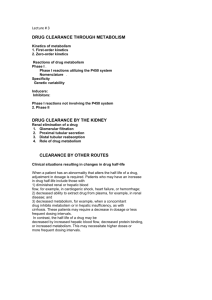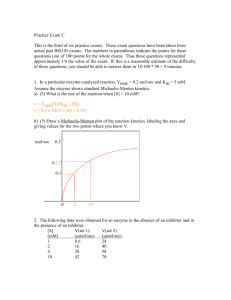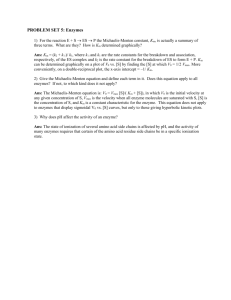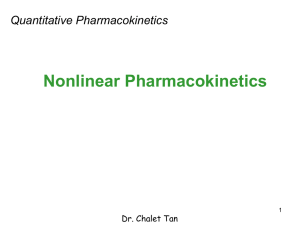Principles of Nonlinear Pharmacokinetics
advertisement
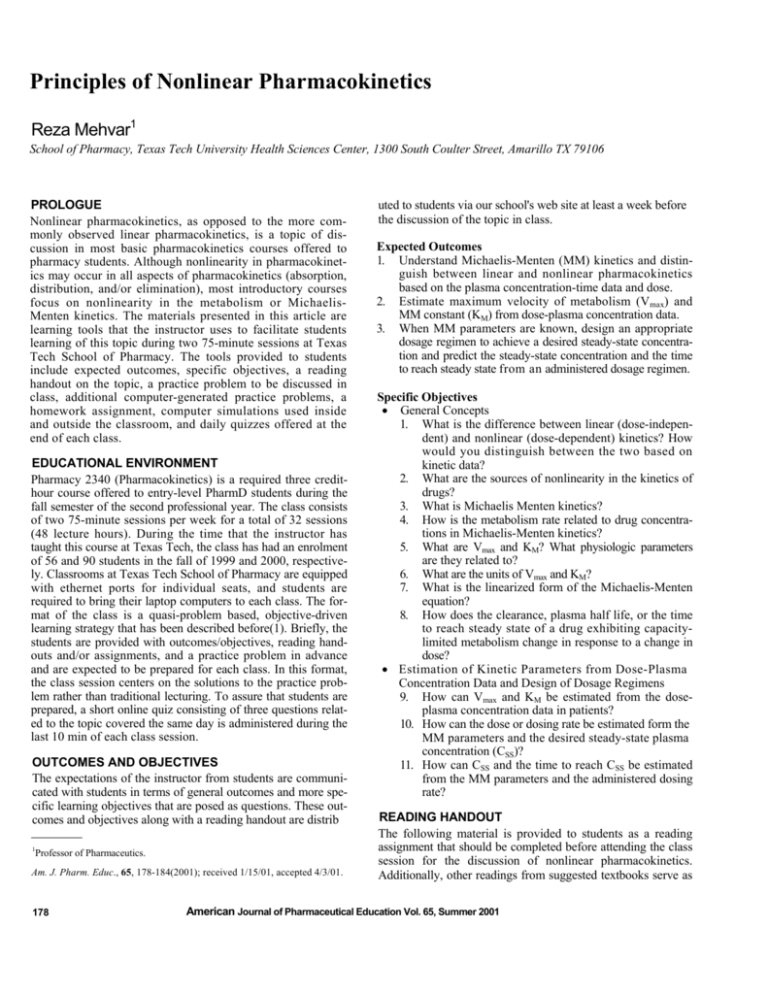
Principles of Nonlinear Pharmacokinetics Reza Mehvar1 School of Pharmacy, Texas Tech University Health Sciences Center, 1300 South Coulter Street, Amarillo TX 79106 PROLOGUE Nonlinear pharmacokinetics, as opposed to the more commonly observed linear pharmacokinetics, is a topic of discussion in most basic pharmacokinetics courses offered to pharmacy students. Although nonlinearity in pharmacokinetics may occur in all aspects of pharmacokinetics (absorption, distribution, and/or elimination), most introductory courses focus on nonlinearity in the metabolism or MichaelisMenten kinetics. The materials presented in this article are learning tools that the instructor uses to facilitate students learning of this topic during two 75-minute sessions at Texas Tech School of Pharmacy. The tools provided to students include expected outcomes, specific objectives, a reading handout on the topic, a practice problem to be discussed in class, additional computer-generated practice problems, a homework assignment, computer simulations used inside and outside the classroom, and daily quizzes offered at the end of each class. EDUCATIONAL ENVIRONMENT Pharmacy 2340 (Pharmacokinetics) is a required three credithour course offered to entry-level PharmD students during the fall semester of the second professional year. The class consists of two 75-minute sessions per week for a total of 32 sessions (48 lecture hours). During the time that the instructor has taught this course at Texas Tech, the class has had an enrolment of 56 and 90 students in the fall of 1999 and 2000, respectively. Classrooms at Texas Tech School of Pharmacy are equipped with ethernet ports for individual seats, and students are required to bring their laptop computers to each class. The format of the class is a quasi-problem based, objective-driven learning strategy that has been described before(1). Briefly, the students are provided with outcomes/objectives, reading handouts and/or assignments, and a practice problem in advance and are expected to be prepared for each class. In this format, the class session centers on the solutions to the practice problem rather than traditional lecturing. To assure that students are prepared, a short online quiz consisting of three questions related to the topic covered the same day is administered during the last 10 min of each class session. OUTCOMES AND OBJECTIVES The expectations of the instructor from students are communicated with students in terms of general outcomes and more specific learning objectives that are posed as questions. These outcomes and objectives along with a reading handout are distrib 1 Professor of Pharmaceutics. Am. J. Pharm. Educ., 65, 178-184(2001); received 1/15/01, accepted 4/3/01. 178 uted to students via our school's web site at least a week before the discussion of the topic in class. Expected Outcomes 1. Understand Michaelis-Menten (MM) kinetics and distinguish between linear and nonlinear pharmacokinetics based on the plasma concentration-time data and dose. 2. Estimate maximum velocity of metabolism (Vmax) and MM constant (KM) from dose-plasma concentration data. 3. When MM parameters are known, design an appropriate dosage regimen to achieve a desired steady-state concentration and predict the steady-state concentration and the time to reach steady state from an administered dosage regimen. Specific Objectives • General Concepts 1. What is the difference between linear (dose-independent) and nonlinear (dose-dependent) kinetics? How would you distinguish between the two based on kinetic data? 2. What are the sources of nonlinearity in the kinetics of drugs? 3. What is Michaelis Menten kinetics? 4. How is the metabolism rate related to drug concentrations in Michaelis-Menten kinetics? 5. What are Vmax and KM? What physiologic parameters are they related to? 6. What are the units of Vmax and KM? 7. What is the linearized form of the Michaelis-Menten equation? 8. How does the clearance, plasma half life, or the time to reach steady state of a drug exhibiting capacitylimited metabolism change in response to a change in dose? • Estimation of Kinetic Parameters from Dose-Plasma Concentration Data and Design of Dosage Regimens 9. How can Vmax and KM be estimated from the doseplasma concentration data in patients? 10. How can the dose or dosing rate be estimated form the MM parameters and the desired steady-state plasma concentration (CSS)? 11. How can CSS and the time to reach CSS be estimated from the MM parameters and the administered dosing rate? READING HANDOUT The following material is provided to students as a reading assignment that should be completed before attending the class session for the discussion of nonlinear pharmacokinetics. Additionally, other readings from suggested textbooks serve as American Journal of Pharmaceutical Education Vol. 65, Summer 2001 Fig. 1. The qualitative relationship between the steady-state plasma concentration (CSS) or area under the plasma concentration-time curve (AUC) and the administered dose for drugs with linear (solid line) and nonlinear (dashed line) pharmacokinetics. Fig. 2. The simulated plasma concentration-time courses of a drug after the intravenous administration of 3 different doses. Average pharmacokinetic parameters of phenytoin (volume of distribution of 50 L, Vmax of 500 mg/day, and Ku of 4 mg/L) were used for the simulation. optional reading assignments. The equations and a majority of introductory concepts presented in the reading handout may be found in most pharmacokinetics textbooks(2-4). Introduction Differentiation between Linear and Nonlinear Kinetics. The pharmacokinetic parameters of most drugs are not expected to change when different doses are administered or when the drug is given through different routes of administration or as single or multiple doses. The kinetics (e.g. clearance and volume of distribution) of these drugs are said to be linear or dose-independent, and this is a characteristic of first-order kinetics. The term linear simply means that if the dose is increased, the plasma concentration or area under the plasma concentration-time curve (AUC) will be increased proportionally, as demonstrated in Figure 1. However, for some drugs, this may not be valid. For example, when the dose of phenytoin is increased by 50 percent in a patient from 300 mg/day to 450 mg/day, the average steady state concentration may increase by as much as ten fold. This dramatic increase in the concentration is due to the nonlinear pharmacokinetics of phenytoin. For these drugs (drugs with nonlinear kinetics or dose-dependent kinetics), the kinetic parameters, such as clearance, volume of distribution, and half life, may vary depending on the administered dose. This is because one or more of the kinetic processes of the drug (absorption, distribution, and/or elimination) may be via a process other than simple first-order kinetics. For these drugs, the relationship between the AUC or CSS and dose is not linear (Figure 1). Additionally, different doses of these drugs may not result in parallel plasma concentration-time courses expected for drugs with linear pharmacokinetics. For example, for drugs with nonlinear metabolism, the initial decline in the plasma concentrations may be slower at higher doses, compared with that after the administration of the lower doses (Figure 2). This means that the rate of elimination is not directly proportional to the plasma concentration for these drugs. The reason for this nonlinearly is explained Fig. 3. Interaction of drug and enzyme based on the MichaelisMenten kinetics. below. Sources of Nonlinearity. As mentioned above, nonlinearity may be at different kinetic levels of absorption, distribution, and/or elimination. For example, the extent of absorption of amoxicillin decreases with an increase in dose(5). For distribution, plasma protein binding of disopyramide is saturable at therapeutic concentrations, resulting in an increase in the volume of distribution with an increase in dose of the drug(6). As for nonlinearity in renal excretion, it has been shown that the antibacterial agent dicloxacillin has saturable active secretion in the kidneys, resulting in a decrease in renal clearance with an increase in dose(7). For metabolism, both phenytoin(2) and ethanol(8) have saturable metabolism which means an increase in the dose would result in a decrease in hepatic clearance and a more than proportionate increase in the drug AUC. Here, nonlinearity in the metabolism, which is one of the most common sources of nonlinearity, will be discussed. Capacity-Limited Metabolism Capacity-limited metabolism is also called saturable metabolism, Michaelis-Menten kinetics, or mixed-order kinetics. The process of enzymatic metabolism of drugs may be explained by the relationship depicted in Figure 3. First, the drug interacts with the enzyme to produce a drug-enzyme intermediate. Then, the intermediate complex is further processed to produce a metabolite and release the enzyme. The released enzyme is recycled back to react with more drug molecules (Figure 3). According to the principles of Michaelis-Menten kinetics, the rate of drug metabolism (v) changes as a function American Journal of Pharmaceutical Education Vol. 65, Summer 2001 179 range of concentrations. However, one may look at different regions of the Michaelis Menten curve (Figure 4) with regard to drug concentrations. At one extreme, the drug concentration (C) may be much lower than KM (Figure 4). In that case, C may be deleted from the denominator of Equation 1: Metabolism Rate= v = VmaxCVmax C (2) = KM KM Because both Vmax and KM are constants, the metabolism rate is proportional to the drug concentration and a constant (i.e., first order process) in this region. At the other extreme, the drug concentrations are much higher than KM. Therefore, KM may be deleted from the denominator: Metabolism Rate = v = Fig. 4. The relationship between the metabolism rate and the drug concentration based on the Michaelis-Menten kinetics. The maximum rate of metabolism and the concentration producing half of the maximum rate of metabolism are shown as Vmax and KM, respectively. Additionally, the two extreme regions of the Michaelis-Menten metabolism are shown with letters L (low drug concentration relative to KM, associated with linear metabolism) and H (high drug concentration relative to KM, associated with constant rate of metabolism). of drug concentration as demonstrated in Figure 4. Based on this relationship (Figure 4), at very low drug concentrations, the concentration of available enzymes is much larger than the number of drug molecules. Therefore, when the concentration of the drug is increased, the rate of metabolism is increased almost proportionally (linearly). However, after certain points, as the concentration increases the rate of metabolism increases less than proportional. The other extreme occurs when the concentration of the drug is very high relative to the concentration of available enzyme molecules. Under this condition, all of the enzymes are saturated with the drug molecules, and when the concentration is increased further, there will be no change in the rate of metabolism of the drug (Figure 4). In other words, the maximum rate of metabolism (Vmax) has been achieved. The rate of metabolism (or rate of elimination if the metabolism is the only pathway of elimination) is defined by the Michaelis-Menten equation: MetabolismRate = v = VmaxC KM + C (1) where Vmax is the maximum rate of metabolism, KM is the Michaelis-Menten constant, and C is the drug concentration. The maximum rate of metabolism (Vmax) is dependent on the amount (or concentration) of enzymes available for metabolism of the drug, while KM is the concentration which produces half of Vmax and is inversely related to the affinity of the drug to the enzyme (the higher the affinity, the lower is KM). The unit of Vmax is the unit of elimination rate and normally is expressed as amount/time (e.g., mg/h). However, in some instances, it may be expressed as concentration/time (e.g., mg/L per hr). The unit of KM is the same as the unit of concentration (KM is the concentration producing half of Vmax). In some instances, KM is expressed as the drug amount producing half of Vmax. Equation 1 describes the relationship between the metabolism (or elimination) rate and the concentration over the entire 180 Vmax C = Vmax C (3) This equation shows that when the drug concentration is much higher than KM’ the rate of metabolism is a constant (Vmax), regardless of drug concentration (Figure 4). This situation is similar to zero-order kinetics when the rate of elimination is constant and independent of the drug concentration or amount. While at two extremes the metabolism follows either firstequation 2) or zero- (Equation 3) order kinetics, at drug concentrations around KM’ a mixed order is observed which is defined by the Michaelis-Menten Equation 1. Clearance, Half Life, and Time to Reach Steady State for Capacity-Limited Drugs. For drugs following MichaelisMenten kinetics at therapeutic doses (e.g. phenytoin), an increase in dose normally results in a more than proportional increase in AUC or CSS This is because the clearance (Cl) of the drug decreases with an increase in the dose (or plasma concentration), as indicated by the following equation: Cl = Vmax C KM + C (4) Because the half life is inversely related to clearance (t1/2 = [0.693 x V]/C1), the apparent half life of the drug will be longer at higher doses or plasma concentrations. This is demonstrated in Figure 2 where at earlier sampling times (<40 hr in this case) the apparent half life of the drug is much longer for the 500-mg dose, compared with the other two lower doses. However, the terminal half life of the drug is the same for all three doses if sampling is conducted long enough for drug concentrations to reach the linear range. Additionally, because the time to reach steady state is dependent on the apparent half life, it is clear that for drugs exhibiting nonlinear kinetics, the time to reach steady state will be dependent on the administered dose; the higher the dose, the longer is the half life and the time to reach steady state. These characteristics are different from those observed for drugs with linear (first-order) kinetics where no change in clearance, half life, or time to reach steady state is expected as a result of a change in the dose. Estimation of Michaelis-Menten Parameters in Patients The Michaelis-Menten equation may be used to estimate the values of Vmax and KM in patients under therapy with a drug exhibiting nonlinear kinetics. One of these drugs is phenytoin, American Journal of Pharmaceutical Education Vol. 65, Summer 2001 1. First, one should calculate R/CSS for each dose: R, mg/day CSS, mg/L R/CSS’ L/day 300 7.9 38 450 30 15 2. Then, each dosing rate value (R) should be plotted against its corresponding R/CSS value on a linear graph, and the intercept and slope calculated (Figure 5). In this case, the Vmax value is 548 mg/day, which is estimated from the y-intercept, and the KM value, estimated from the slope, is 6.5 mg/L (Figure 5). Obviously, if only one plasma concentration-dose data pair is available, the above method cannot be used, and the patient-specific Vmax and KM values cannot be estimated unequivocally. However, an estimate of patient's parameters may be obtained using an orbit nomogram(9), which has been constructed for phenytoin dosing based on probability principles. Alternatively, one may substitute a population average value of KM (4 mg/L) for phenytoin in Equation 6 or 7, along with the dosing rate and the observed plasma concentration, to estimate Vmax in the patient. Estimation of Dosing Rate (R) or CSS Values from MM Parameters Fig. 5. Estimation of Vmax and KM values from the dosing rate (R) and steady-state concentration (CSS) data. which is eliminated completely by metabolism governed by MM kinetics. If the drug is given on a multiple dosing basis, then the rate of metabolism of the drug at steady state will be a function of steady state concentration (CSS) of the drug in plasma: Eliminatio n Rate = Metabolism Rate = v = Vmax CSS (5) K M + CSS Please remember that at steady sate, the rate of elimination is equal to the drug dosing rate (R): V C R = max SS K M + C SS (6 ) In order to estimate Vmax and KM’ one may first linearize the above equation. There are several methods that the above equation can be rearranged to make it linear. One such linearized equation that is used for phenytoin dosing is shown below: R = Vmax − K M R C SS (7 ) Equation 7 indicates that a plot of R versus R/CSS will be linear with a slope of -KM and an intercept of Vmax. To construct such a plot and estimate the values of the MM parameters, one needs at least two sets of doses along with their corresponding CSS values. Example. The steady state concentration of phenytoin after oral administration of 300 mg of the drug every day for 30 days was 7.9 mg/L in a patient. When the dose was increased to 450 mg/day, CSS’ obtained 35 days later (steady state), was 30 mg/L. Please determine Vmax and KM of phenytoin in this patient. Assume an oral bioavailability (F) of 1 for phenytoin. If the MM parameters are known in a patient or the reported values in the literature are used, one may estimate the dosing rate (R) necessary to achieve a desired CSS. For example, in the above case for phenytoin, the estimated MM parameters may be used in Equation 6 to determine a dosing rate for a steady state of 15 mg/L (the therapeutic range of phenytoin is between 10 to 20 mg/L): R= V max C SS 548mg / dayx15mg / L 8220 = = 6.5mg / L + 15mg / L 21.5 K M + C SS = 382mg / day Alternatively, if the MM parameters and the administered dosing rate are known, one may predict CSS. Equation 6 may be rearranged to solve for CSS: C SS = K V M max R − R (8 ) For example, in the above case, if a dose of 400 mg/day is administered, one can predict CSS: C SS = 6.5 x 400 2600 = = 17.6mg / L 548 − 400 148 Estimation of the Time to Reach Steady State As mentioned above, the half life and, therefore, the time to reach steady state for drugs with nonlinear kinetics are dependent on the dosing rate. The time to reach 90% of steady state (t90%) (3.3 t1/2's) for drugs which are eliminated by Michaelis-Menten metabolism only (e.g. phenytoin) may be estimated by the following equation(2): t 90% = KMV (Vmax − R ) 2 (2.3 xVMAX − 0.9 xR) (9) As demonstrated in this equation, in addition to the dosing rate American Journal of Pharmaceutical Education Vol. 65, Summer 2001 181 Table I. Effects of dosing rate on the steady state plasma concentrations (C S S ) and the time to reach 90 percent of steady state (t90%)a Dosing Rate (mg/day) 100 200 250 300 400 450 CSS, b mg/L 1.00 2.67 4.00 6.00 16.0 36.0 t90%,c day 1.33 2.16 2.96 4.40 15.8 59.6 a Based on average kinetic parameters of phenytoin: maximum velocity of metabolism of 500 mg/day, Michaelis-Menten constant of 4 mg/L, and volume of distribution of 50 L. b Equation 8. c Equation 9. (R), the time to reach steady state for drugs with nonlinear kinetics is also affected by the values of Vmax’ KM’ and volume of distribution (V) of the drug. In the above example, it takes 14 days to reach t90% after the administration of 400 mg of the drug per day (assuming a V of 50 L for phenytoin): t90% = 6.5x50 (2.3x548− 0.9x400) = 13.4days (548− 400) 2 Table I lists the values of CSS (Equation 8) and t90% (Equation 9) for different dosing rates assuming average values(2) of Vmax (500 mg/day), KM (4 mg/L), and V (50 L) for phenytoin in a 70 kg subject. As shown in the table, an increase in the dose not only results in a more than proportional increase in CSS, it also causes a dramatic increase in the time to reach steady state. Based on the average kinetic values for phenytoin, it takes at least 16 days to reach a therapeutic concentration of 16 mg/L after the administration of a 400 mg/day dosing rate (Table I). Conditions Altering Vmax and/or KM Under certain circumstances (disease states, age, and drug interactions), the Vmax and KM values of a drug may change. For example, concurrent administration of carbamazepine or phenobarbital with phenytoin results in an increase in the Vmax of phenytoin (enzyme induction)(2). Therefore, it may be necessary to increase the dosing rate of phenytoin if phenobarbital or carbamazepine is added to a patient's regimen. Also, if the concentrations of phenytoin are optimal in the presence of phenobarbital or carbamazepine, discontinuation of the interacting drug may necessitate a decrease in the dosing rate of phenytoin. Conversely, hepatic cirrhosis(2) causes a decrease in the Vmax of phenytoin, resulting in higher plasma concentrations if the same dose is administered. Additionally, drugs such as cimetidine or chloramphenicol cause an increase in the KM value of phenytoin, resulting in higher than expected plasma concentrations of phenytoin(2). In terms of clinical significance, those situations (e.g. age, drug interactions and disease states) which are associated with changes in the Vmax produce more dramatic changes in the rate of metabolism and CSS of the drug, compared with changes resulting from the alteration in the KM value. For illustration, the effects of a two-fold increase in the Vmax or KM value of a drug on its metabolism rate or CSS are depicted in Figure 6. Under normal conditions (no change in Vmax or KM), an increase in the dosing rate causes a nonlinear increase in CSS 182 Fig. 6. The relationships between the steady-state plasma concentration (CSS) and dosing rate (R) (left panels) and between the metabolism rate and CSS (right panels) when the Vmax (top) or KM (bottom) value of the drug is altered. (Figure 6, left panel). A two-fold increase in the value of KM results in a proportional two fold increase in CSS’ regardless of the dosing rate (Figure 6). However, a two-fold change (increase) in the Vmax value causes a more than two-fold change (decrease) in CSS’ the effect being more dramatic at dosing rates closer to the Vmax value (Figure 6). Similarly, a change in Vmax is associated with more dramatic effects on the metabolism rate of the drug, compared with a change in KM (Figure 6, right panel). Therefore, conditions which alter the Vmax of drugs with nonlinear kinetics are clinically more relevant at steady-state. PRACTICE PROBLEMS, SIMULATIONS, QUIZZES AND ASSIGNMENTS During the class session, a brief (approximately 10-15 minutes) overview of the topic is offered by the instructor. Thereafter, the solution to a practice problem (Appendix A), which is developed based on the outcomes and objective of the topic, is discussed. Online computer simulations are used by both the instructor and students to reinforce the concepts. These simulations depict the effects of alterations in dose and/or Michaelis-Menten parameters on the plasma concentration-time profiles and the relationships between the AUC and dose and between metabolism rate and plasma concentrations. Finally, during the last 10 minutes of each session, an online quiz(10) is administered consisting of three concept and/or calculation questions that are unique for each student. The online quizzes provide immediate feedback to students regarding both their grades and correct answers to the problems(10). Additionally, students may review their quizzes after the class session is ended. A computer generated, on-line assignment(11) developed for this topic (Appendix B) is due by the end of the day the discussion of the topic in class is completed. The online assignment allows unlimited number of practices before the actual assignment is submitted(11). CONCLUSIONS The learning tools used by this instructor in a pharmacokinetics course offered to entry-level PharmD students are present American Journal of Pharmaceutical Education Vol. 65, Summer 2001 ed for the topic of nonlinear pharmacokinetics (as related to Michaelis-Menten kinetics). These tools consist of specific outcomes/objectives, a reading handout, a practice problem as a focus of in-class discussion, and online, web-based computer simulations, take-home assignments, and in-class daily quizzes. Except for quizzes, students are provided with all the tools in advance of the class sessions for this topic and are expected to attend the class prepared and be able to take a quiz at the end of each session. References (1) Mehvar, R., “Development and evaluation of a quasi problem-based, objective-driven learning strategy in introductory and clinical pharmacokinetics courses,” J Pharm. Teaching, 7, 17-29(1999). (2) Tozer, T.N. and Winter, M.E., “Phenytoin,” in Applied Pharmacokinetics. Principles of Therapeutic Drug Monitoring, (edits., Evans, W.E., Schentag, J.J., Jusko, W.J.), Applied Therapeutics, Inc., Vancouver WA (1992) pp. 25-1-25-44. (3) Rowland, M. and Tozer, T.N., Clinical Pharmacokinetics: Concepts and Applications, Williams &Wilkins, Philadelphia PA (1995). (4) Shargel, L. and Yu, A.B.C., Applied Biopharmaceutics and Pharmacokinetics, Appleton & Lange, Norwalk CT (1999). (5) Paintaud, G., Alvan, G., Dahl, M.L., Grahnen, A., Sjovall, J. and Svensson, J.O., “Nonlinearity of amoxicillin absorption kinetics in human,” Eur. J. Clin. Pharmacol., 43, 283-288(1992). (6) Giacomini, K. and Blaschke, T, “Effect of concentration-dependent binding to plasma proteins on the pharmacokinetics and pharmacodynamics of disopyramide,” Clin. Pharmacokinet., 9, 42-48(1984). (7) Nauta, E.H. and Mattie, H., “Dicloxacillin and cloxacillin: pharmacokinetics in healthy and hemodialysis subjects,” Clin. Pharmacol. Ther., 20, 98-108(1976). (8) Wilkinson, P.K., “Pharmacokinetics of ethanol: Areview,” Alcohol Clin. Exp. Res., 4, 6-21(1980). (9) Vozeh, S., Muir, K.T., Sheiner, L.B. and Follath, E, “Predicting individual phenytoin dosage,” J. Pharmacokinet. Biopharm., 9, 131-146(1981). (10) Mehvar, R., “Creation of a dynamic question database for pharmacokinetics,” Am. J. Pharm. Educ., 64, 441-445(2000). (11) Mehvar, R., “Online, individualized, and interactive pharmacokinetic scenarios with immediate grading and feedback and potential for use by multiple instructors,” ibid., 63, 348-353(1999). APPENDIX A. PRACTICE PROBLEM Three doses of a new drug were administered via IV bolus route to a group of patients and the average of plasma concentration time data were reported: Dose = 10 mg Dose = 200 Dose = 500 mg Time, hr Cone., mg/L Time, hr Cone., mg/L Time, hr Cone., mg/L 0 0.500 0 10.0 0 25.0 2.75 0.300 5 7.00 16 12.5 0.250 14.5 2.50 26 6.25 4.0 11 0.0625 19 1.25 39 1.27 20 0.0120 25 0.480 44 0.460 33 0.0800 48 0.220 1. Plot all three data sets on the same semilog graph (you need a 4cycle graph). 2. For each dose, identify the portion of the plasma concentrationtime data which is linear. Use the linear data to estimate the half life of the drug for the three doses. 3. For each of the three doses, estimate the time required for the plasma concentration to decline from the initial concentration 4. 5. 6. (C0) to one half of C0. Are the values different? Why? Using the trapezoidal method, estimate the AUC0-inf of the drug for the three doses. Plot the AUC0-inf versus the administered dose on a linear graph. Is the relationship linear? Why? Calculate clearance for all three doses? Are the values dose dependent? This drug is eliminated almost completely by sulfate conjugation in the liver. The conjugate is then eliminated very rapidly into urine. Therefore, the rate of metabolism of the drug may be indirectly estimated from the urinary excretion of the conjugate. This method was used to determine the rate of drug metabolism at various steady state plasma concentrations of the drug after its IV infusion. The data are presented below: Fig. 7. (Appendix A). The relationship between the metabolism rate and the steady-state plasma concentration (CSS) in the presence (dashed line) and absence (solid line) of a drug interaction. Plasma Cone. (mg/L) Metabolism Rate (mg/h) 0 0.05 0.1 0.2 0.5 1 2.5 5 10 20 30 35 40 0 0.20 0.39 0.77 1.82 3.33 6.67 10.0 14.0 18.0 19.8 20.0 20.0 American Journal of Pharmaceutical Education Vol. 65, Summer 2001 183 7. 8. 9. 10. 11. 12. 13. 14. Plot the Rate of metabolism versus the plasma concentrations of the drug on a linear graph (For ease of plotting, you may start at the plasma cone, of 0.5 mg/L). Is the relationship linear (characteristic of first order kinetics)? Why? What is the equation describing the relationship observed above? What are the equations for the two extreme cases of concentrations (very low and very high concentrations)? What are the two parameters defining the shape of the Michaelis Menten (MM) curve (metabolism rate vs. cone, curve)? What are the values of maximum rate of metabolism (VMAX) and MM constant (KM) for this drug? What are their units? What physiological parameters are related to VMAX and KM? The therapeutic range of the drug is between 10-30 mg/L. Do you expect linear or nonlinear kinetic behavior for this drug with therapeutic doses? Co-administration of an interacting drug results in the following changes in the metabolism rate versus steady state plasma concentration plot (Figure 7). What is the mechanism of this interaction? It is reported that cimetidine reduces the metabolism of this drug by a competitive inhibition mechanism, resulting in a two-fold increase in the MM constant of the drug. Additionally, phenobarbital causes an enzyme induction resulting in a two-fold increase in the Vmax of the drug. Which of these two interacting drugs (phenobarbital or cimetidine) has a potential to cause a more dramatic change in the CSS of this new drug? Why? Dose(mg) CSS(mg/L) I. II. To investigate the relationship between the administered dose and the steady state concentration (CSS) in a patient, three different doses of the drug were administered orally on different occasions. The drug has an oral bioavailability of 1. Each dose was administered on a daily basis until the achievement of steady sate, and CSS was measured before increasing the dose to the next level. The results are presented below: Dosing Rate (mg/day) CSS (mg/L) 150 2.27 300 9.30 450 73.8 10 1.61 40 10.9 60 28.1 Assuming a complete oral bioavailability, insignificant fluctuation in plasma concentrations at steady state, and complete elimination through metabolism, please estimate the following parameters: 1. The maximum velocity of the metabolism (Vmax) 2. The Michaelis-Menten constant (KM) 3. CSS if 50 mg of kinetoin is administered every 6 hr. 4. The dose to be administered every 6 hr, if the desired CSS is 14 mg/L. 5. The therapeutic plasma concentration range of kinetoin is 10-25 mg/L. Is the metabolism of kinetoin linear or nonlinear at therapeutic concentrations? Additionally, when kinetoin is administered along with a drug which is known to interact with kinetoin, steady state concentrations of 5.33 mg/L (after a dose of 15 mg) or 61.7 mg/L (after a dose of 60 mg) are observed. Assuming the same dosage interval as in section I, please estimate the following parameters in the presence of the interacting drug: 1. The maximum velocity of the metabolism (Vmax) 2. The Michaelis-Menten constant (KM) 3. The mechanism of this interaction is: A. A decrease in the concentrations of available enzymes B. An increase in the concentrations of available enzymes C. An increase in the affinity of the enzymes D. A decrease in the affinity of enzymes 15. Estimate the VMAX and KM values in this patient from the above data. 16. Knowing the Michaelis Menten parameters in this patient, please estimate CSS after the administration of 350 mg per day doses of the drug. 17. Assuming no drug is left in the body of the patient before the new dose of 350 mg/day is administered, how long does it take to reach steady state with this dose? 18. Knowing the Michaelis Menten parameters in this patient, please estimate the daily dose necessary to achieve a CSS of 20 mg/L. APPENDIX B. COMPUTER ASSIGNMENT The following assignment is generated by computers with a unique set of data for each student. The underlined data indicate dynamic data which may be different for each student. With regard to multiple choice questions, all answers are possible, depending on the data. Three oral doses of kinetoin were administered every 6 hr to a patient on three different occasions. Each dose was administered until the achievement of steady state. The doses and respective steady-state concentration (CSS) values are reported below: 184 Fig. 8. (Appendix B). Possible four scenarios for the relationship between the metabolism rate and the steady-state plasma concentration (CSS) in the presence (dashed line) and absence (solid line) of a drug interaction. 4. 5. Which of the following figures (Figure 8) describes qualitatively this interaction (solid line in the absence and dashed line in the presence of interaction)? What dose should be administered every 6 hr if the desired CSS of 14 mg/L is to be achieved in the presence of the interacting drug? American Journal of Pharmaceutical Education Vol. 65, Summer 2001
